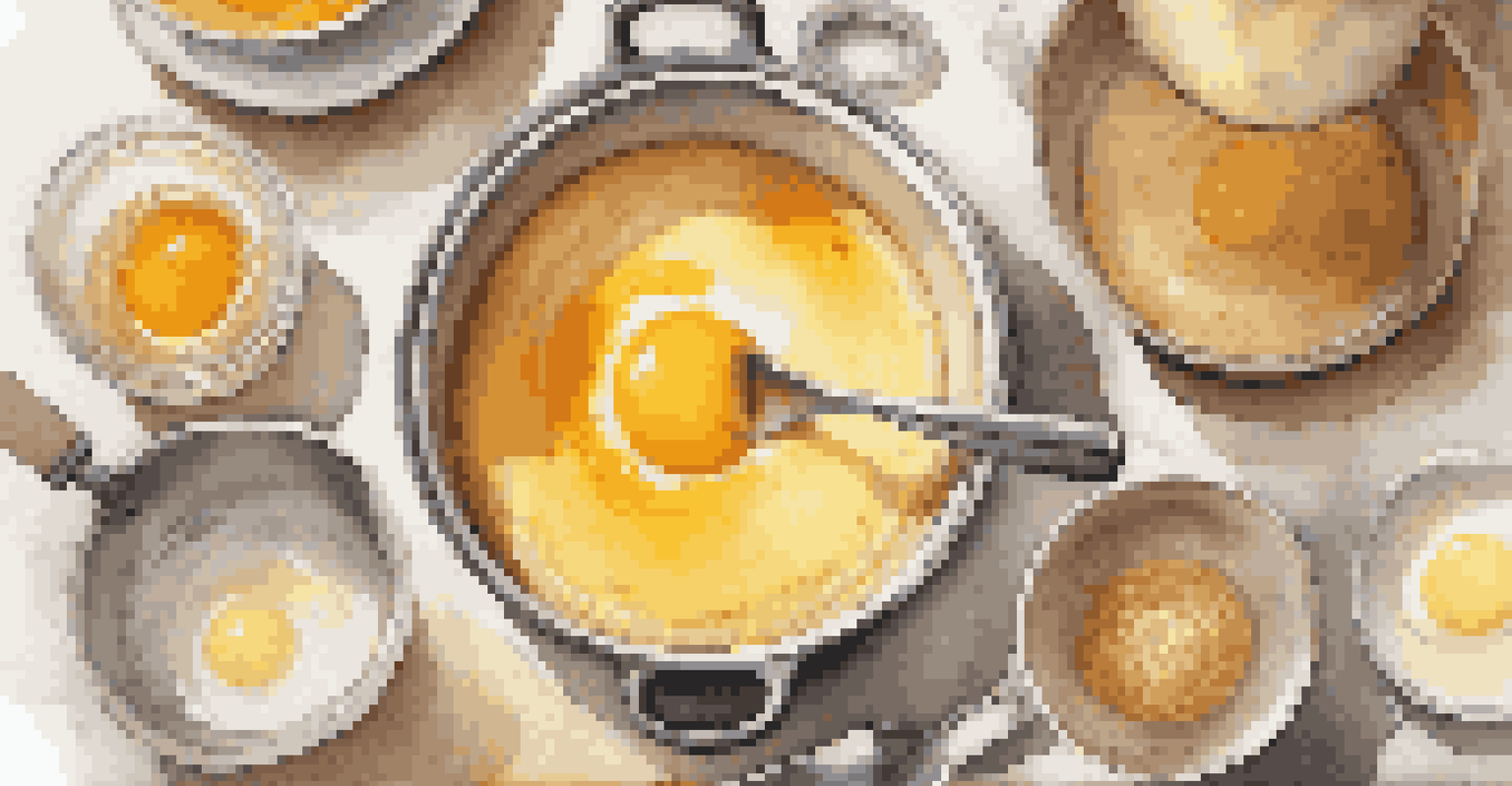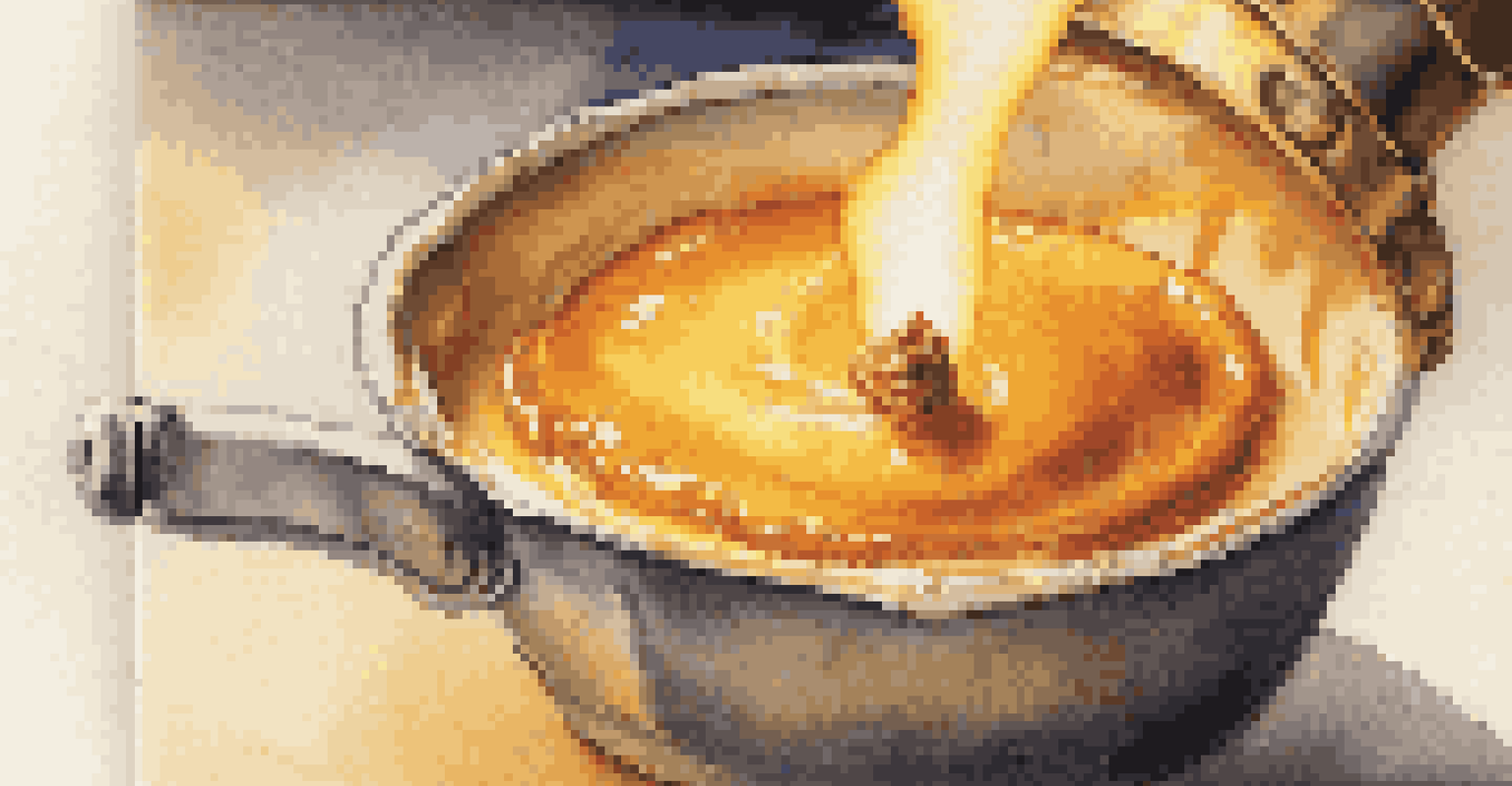Advanced Crème Brûlée: Techniques for Perfect Custards

Understanding the Basics of Crème Brûlée
Crème brûlée is a classic French dessert known for its creamy custard base and crunchy caramelized sugar topping. At its core, the dessert consists of just a few key ingredients: heavy cream, egg yolks, sugar, and vanilla. The magic happens when these ingredients are combined and baked gently, allowing the custard to set while remaining velvety smooth. Understanding this foundation is crucial for mastering more advanced techniques.
Desserts are the fairy tales of the kitchen—a happily-ever-after to supper.
Many people assume that making crème brûlée is complicated, but with the right approach, anyone can achieve that perfect balance of textures. The key lies in the careful selection of ingredients and the method of preparation. As you dive deeper into the world of crème brûlée, you’ll discover how small adjustments can lead to big differences in flavor and texture.
So, whether you're a home cook or a budding pastry chef, getting comfortable with the basics of crème brûlée is the first step toward crafting your own variations. Once you have a firm grasp on these foundational elements, you'll be ready to explore more advanced techniques that will elevate your dessert game.
Selecting the Right Ingredients for Custard
When it comes to making crème brûlée, the quality of your ingredients matters immensely. Start with fresh, high-quality heavy cream, as it forms the base of your custard. Opting for organic or locally sourced cream can enhance the flavor profile significantly, adding a rich, creamy texture that is hard to beat.

Next up are the egg yolks, which are crucial for achieving that luxurious custard consistency. Using large, fresh egg yolks is advisable, as they provide the necessary fat and richness. Some chefs even recommend using a combination of egg yolks and whole eggs for a slightly different texture, but this is a matter of personal preference.
Master the Basics of Crème Brûlée
Understanding the essential ingredients and techniques is key to successfully creating this classic French dessert.
Lastly, don't skimp on the sugar and vanilla. Granulated sugar should be used for the custard, while a high-quality vanilla bean or pure vanilla extract will add depth and aroma. Remember, these simple ingredients work together to create a dessert that feels indulgent, so choose wisely.
Mastering Custard Preparation Techniques
The preparation of the custard is where many home cooks struggle, but mastering this step is essential for a perfect crème brûlée. Start by gently heating the cream with vanilla until it just begins to simmer, then remove it from the heat. This step helps to infuse the cream with vanilla flavor while preventing it from boiling, which can affect the texture.
Cooking is an observation-based process that you can't get exclusively from a cookbook. You have to see it in action, and then you can write your own recipes.
Next, whisk the egg yolks and sugar together until they turn pale and creamy. This process, known as 'blanching,' helps to dissolve the sugar and creates a smooth mixture. Gradually add the warm cream to the egg mixture, whisking continuously to ensure that the eggs do not curdle. This gentle incorporation is key to achieving a silky custard.
Once combined, strain the mixture through a fine-mesh sieve to remove any lumps, ensuring a smooth final product. Pour the strained custard into ramekins, and you're on your way to creating a dessert that will impress everyone at your dinner table.
Baking Techniques for Smooth Custards
Baking crème brûlée requires a bit of finesse to achieve that perfect, smooth consistency. The traditional method is to use a water bath, or 'bain-marie,' which helps regulate the temperature during baking. By placing your ramekins in a larger dish filled with hot water, you create an even heat distribution that prevents the custard from cooking too quickly.
It's important to preheat your oven to a low temperature, typically around 325°F (160°C). This allows the custard to cook gently, resulting in that creamy texture we all love. Baking times can vary, but you're looking for a custard that is set around the edges but still slightly wobbly in the center.
Importance of Quality Ingredients
Using fresh, high-quality heavy cream, egg yolks, and sugar significantly enhances the flavor and texture of your custard.
Once the baking is done, let the custards cool at room temperature before chilling them in the refrigerator. This cooling period helps the flavors meld together beautifully, setting the stage for a delightful dessert experience.
Chilling and Setting Your Custard
After baking, it's crucial to chill your crème brûlée properly to achieve the right texture. Place the ramekins in the refrigerator for at least two hours, or preferably overnight. This resting period allows the custard to firm up and enhances the overall flavor as the ingredients continue to meld together.
During this chilling time, the custard will develop a richer taste, and the texture will become even silkier. It’s tempting to skip this step, but patience is truly a virtue when it comes to making crème brûlée. Once chilled, your custard will be ready for that iconic caramelized sugar topping.
Before serving, consider letting the custard sit at room temperature for about 20 minutes. This small adjustment will make the dessert more enjoyable, as the flavors will be more pronounced, and the texture will soften slightly, making each spoonful a true delight.
Caramelizing the Sugar: Tips and Tricks
Caramelizing the sugar on top of your crème brûlée is where the magic really happens. For this step, it's essential to use granulated sugar for an even melt. Sprinkle a thin, even layer of sugar across the surface of the chilled custard, ensuring that it covers the entire top without clumping.
You can use a kitchen torch for the caramelization process, which allows for precise control. Move the flame evenly across the surface, watching as the sugar melts and transforms into a beautiful caramel layer. If you don’t have a torch, you can also place the ramekins under a broiler, but keep a close eye on them to avoid burning.
Chill and Caramelize with Care
Proper chilling and careful caramelization of the sugar topping are crucial steps for achieving the perfect balance of creamy and crunchy textures.
Once caramelized, let the sugar cool for a minute before indulging. The contrast between the crunchy sugar and the creamy custard creates a delightful texture that is sure to impress your guests. Remember, the first crack of that sugar crust is part of the experience!
Serving Suggestions and Variations
When it comes to serving crème brûlée, presentation can elevate the experience even further. Consider garnishing with fresh fruit, like berries or a sprig of mint, to add a pop of color and freshness. Plating the ramekin on a decorative plate can also create a visually stunning dessert that looks as good as it tastes.
For those looking to experiment, there are countless variations of crème brûlée to explore. Infuse flavors such as espresso, lavender, or citrus zest into your custard for a unique twist. Each variation offers a different taste experience while still maintaining that classic crème brûlée feel.

Don't be afraid to get creative! You can even create a layered dessert by serving your crème brûlée in a parfait glass with layers of fruit or cake. The possibilities are endless, and each iteration can introduce your guests to a new favorite dessert.